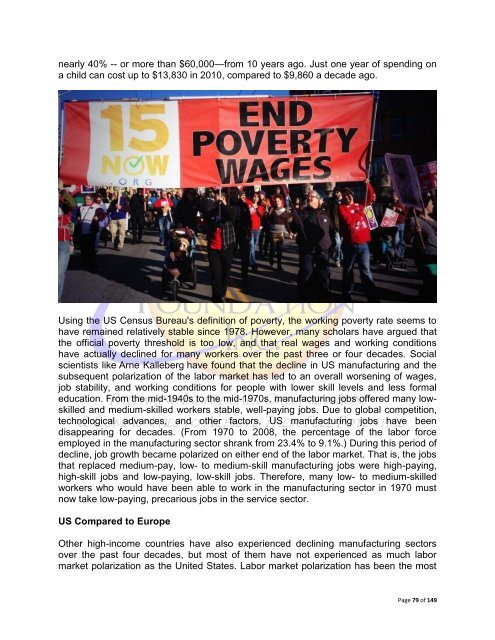Hidden Unemployment
Hidden Unemployment
Hidden Unemployment
Create successful ePaper yourself
Turn your PDF publications into a flip-book with our unique Google optimized e-Paper software.
nearly 40% -- or more than $60,000—from 10 years ago. Just one year of spending on<br />
a child can cost up to $13,830 in 2010, compared to $9,860 a decade ago.<br />
Using the US Census Bureau's definition of poverty, the working poverty rate seems to<br />
have remained relatively stable since 1978. However, many scholars have argued that<br />
the official poverty threshold is too low, and that real wages and working conditions<br />
have actually declined for many workers over the past three or four decades. Social<br />
scientists like Arne Kalleberg have found that the decline in US manufacturing and the<br />
subsequent polarization of the labor market has led to an overall worsening of wages,<br />
job stability, and working conditions for people with lower skill levels and less formal<br />
education. From the mid-1940s to the mid-1970s, manufacturing jobs offered many lowskilled<br />
and medium-skilled workers stable, well-paying jobs. Due to global competition,<br />
technological advances, and other factors, US manufacturing jobs have been<br />
disappearing for decades. (From 1970 to 2008, the percentage of the labor force<br />
employed in the manufacturing sector shrank from 23.4% to 9.1%.) During this period of<br />
decline, job growth became polarized on either end of the labor market. That is, the jobs<br />
that replaced medium-pay, low- to medium-skill manufacturing jobs were high-paying,<br />
high-skill jobs and low-paying, low-skill jobs. Therefore, many low- to medium-skilled<br />
workers who would have been able to work in the manufacturing sector in 1970 must<br />
now take low-paying, precarious jobs in the service sector.<br />
US Compared to Europe<br />
Other high-income countries have also experienced declining manufacturing sectors<br />
over the past four decades, but most of them have not experienced as much labor<br />
market polarization as the United States. Labor market polarization has been the most<br />
Page 79 of 149

















